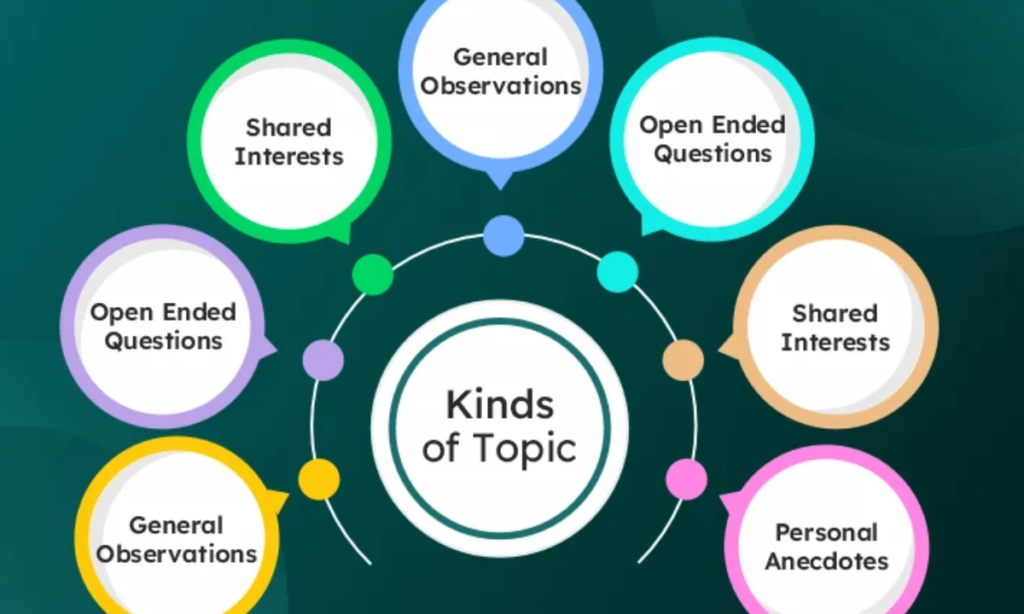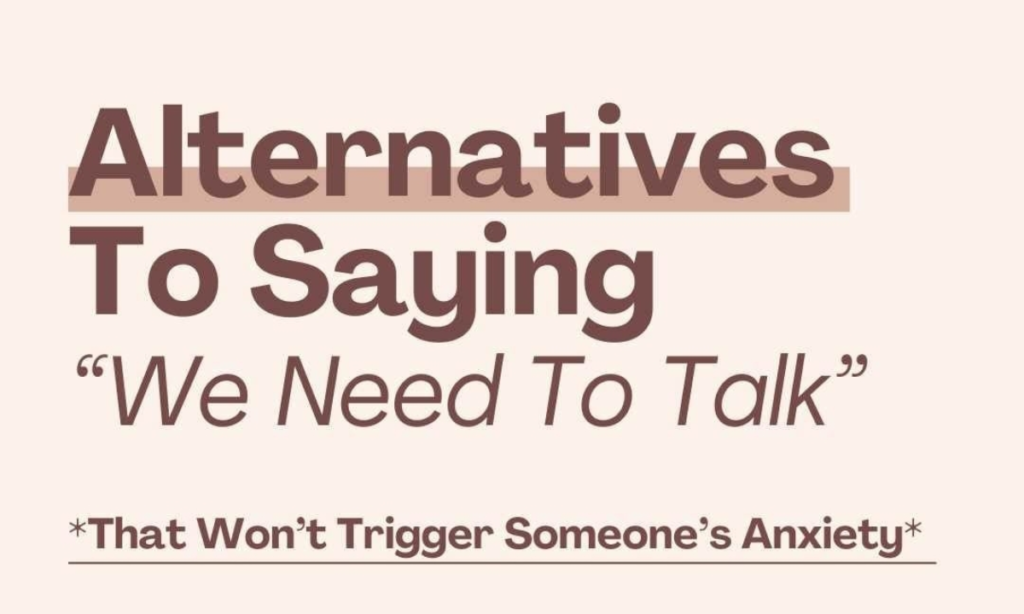“Alternative Ways to Say ‘We Need to Talk'” refers to different phrases that convey the need for a serious conversation. These options help soften the message and make it less intimidating. Using varied language can encourage more open and constructive dialogue.
Are you dreading that serious conversation? Finding the right words can ease tension and promote open dialogue. Discover alternative ways to say, “We need to talk,” and make your discussions more approachable!
When you need to address something important, using alternative phrases can help. Instead of saying, “We need to talk,” try “Can we have a quick chat?” or “I’d like to discuss a few things.” These options sound less intimidating and encourage open communication. Choosing the right words can make a big difference in how the conversation goes.
22 Other Ways to Say “We Need to Talk”
There are many ways to say, “We need to talk,” without sounding too harsh. Using different phrases can help set the right tone for your conversation. It’s important to express your feelings clearly while being considerate.
You might say, “Can we chat for a moment?” or “I have something on my mind I’d like to discuss.” These alternatives keep the conversation open and friendly. Finding the right words makes it easier to address serious topics without causing stress.
Formal and Serious Expressions

1. It’s imperative we have a discussion
Emphasises Urgency: The phrase conveys the importance and urgency of the conversation. It signals that the topic at hand requires immediate attention and cannot be postponed, highlighting its significance in the relationship or situation.
Encourages Open Communication: Stating that a discussion is imperative fosters an environment of open communication. It encourages all parties involved to express their thoughts and feelings candidly, which can lead to clearer understanding and resolution of issues.
Highlights Accountability: By asserting the need for a discussion, it establishes a sense of accountability among participants. Each person is prompted to engage seriously, ensuring that all relevant viewpoints are considered and addressed effectively.
For more details visit other ways to say family emergency
2. A meeting is required to address this matter
Establishes Formality: The phrase indicates that the issue at hand is significant enough to warrant a formal meeting. This sets the tone for a serious discussion and prepares participants for a structured conversation.
Facilitates Focused Dialogue: A meeting provides a dedicated time and space for all parties to discuss the matter in detail. It allows for focused dialogue, ensuring that everyone has the opportunity to contribute and clarify their perspectives.
Promotes Collaborative Problem-Solving: By convening a meeting, it encourages teamwork and collaboration. Participants can collectively brainstorm solutions, share insights, and develop actionable plans to address the matter effectively.
3. We must deliberate on this issue
Encourages Thoughtful Consideration: The phrase emphasises the need for careful and thoughtful consideration of the issue. It suggests that taking time to reflect and analyse various aspects is crucial before making a decision.
Promotes Diverse Perspectives: Deliberation invites input from multiple viewpoints. This collaborative approach ensures that all relevant opinions and insights are considered, leading to a more comprehensive understanding of the issue at hand.
Leads to Informed Decision-Making: By deliberating, individuals can weigh the pros and cons of different options. This process helps in making more informed decisions, reducing the likelihood of errors or oversight that could arise from hasty conclusions.
Suggestive Implications
4. There’s a matter we should discuss
Initiates Important Conversation: The phrase signals that there is a significant topic that requires attention. It acts as a prompt for the other person to prepare for an important discussion, highlighting that the subject is worthy of their time.
Creates a Sense of Urgency: By stating that there’s a matter to discuss, it conveys a sense of urgency without being overly forceful. This encourages the other party to prioritise the conversation, indicating that the issue is important and needs addressing soon.
Fosters Open Dialogue: This phrase opens the door for honest communication. It encourages both parties to share their thoughts and feelings, promoting a collaborative environment where ideas can be exchanged freely and solutions can be explored together.
5. I believe a conversation is in order
Affirms the Need for Communication: This phrase expresses a strong conviction that a discussion is necessary. It conveys that the speaker recognizes the importance of addressing specific topics, ensuring that issues do not go unresolved.
Encourages Timely Engagement: By stating that a conversation is “in order,” it emphasises the need for timely dialogue. This urgency can prompt the other party to engage quickly, preventing misunderstandings or conflicts from escalating further.
Promotes Respectful Interaction: The phrasing suggests a respectful approach to communication. It indicates that the speaker values the other person’s input and believes that their perspective is essential in the discussion, fostering a collaborative atmosphere.
6. It would be beneficial to talk things through
Encourages Clarity and Understanding: The phrase suggests that discussing the issue in detail can lead to greater clarity. By talking things through, both parties can better understand each other’s perspectives, reducing confusion and misinterpretation.
Facilitates Problem-Solving: Talking things through allows individuals to collaboratively explore solutions. This open dialogue encourages brainstorming and critical thinking, helping to identify effective ways to resolve the matter at hand.
Strengthens Relationships: Engaging in open conversation fosters a sense of connection and trust between individuals. By taking the time to talk things through, it shows that both parties value the relationship and are willing to invest effort in maintaining it.
Requesting Personal Discussion

7. Can we set aside time for a chat?
Suggests Prioritization: This phrase indicates that the conversation is important enough to warrant dedicated time. It encourages the other person to prioritise the discussion, signalling that the topic deserves focused attention.
Promotes Scheduling Flexibility: By asking to set aside time, it opens the door for both parties to agree on a convenient moment. This flexibility ensures that neither person feels rushed, allowing for a more productive and meaningful conversation.
Encourages Informal Dialogue: The use of the word “chat” conveys a friendly and approachable tone. It suggests that the conversation can be relaxed and informal, helping to ease any potential tension and making it easier for both parties to express themselves openly.
8. I’d appreciate a moment of your time
Demonstrates Respect: This phrase shows that the speaker values the other person’s time and acknowledges their busy schedule. By asking for just a moment, it conveys respect for their commitments while expressing the need for a conversation.
Sets a Polite Tone: The wording creates a polite and courteous atmosphere, making it more likely that the other person will be receptive to the request. It softens the approach, encouraging a positive response and engagement.
Indicates Importance of the Topic: By requesting a moment of their time, it suggests that there is something significant to discuss. This creates a sense of urgency and importance around the conversation, motivating the other person to prioritise the discussion.
9. Could we have a word?
Suggests Informality: This phrase conveys a casual tone, indicating that the conversation doesn’t need to be overly serious or formal. It creates a comfortable environment for dialogue, making it easier for the other person to engage.
Indicates a Need for Privacy: By asking to “have a word,” it implies that the topic may require a private discussion. This signals to the other person that the conversation might involve sensitive information or feelings that are best addressed away from others.
Encourages Open Communication: The phrasing invites a dialogue, allowing for a straightforward conversation about any topic. It suggests that the speaker is ready to share their thoughts while also encouraging the other person to contribute, fostering an atmosphere of collaboration.
Indicating Concern or Importance
10. There’s something pressing we need to address
Conveys Urgency: This phrase clearly communicates that the matter at hand requires immediate attention. It emphasises the importance of addressing the issue promptly, which can help prioritise discussions in a busy environment.
Indicates Seriousness of the Topic: By using the word “pressing,” it signals that the issue is significant and cannot be ignored. This helps to prepare the other party for a serious conversation, setting the tone for the discussion.
Encourages Action-Oriented Dialogue: The phrasing suggests that the conversation should focus on finding solutions or taking necessary actions. It motivates both parties to engage in problem-solving and collaborative decision-making to resolve the pressing issue effectively.
11. We should have a sit-down regarding
Indicates a Formal Discussion: The term “sit-down” suggests a more formal and structured conversation, signalling that the topic is serious and requires focused attention. This prepares participants for a thorough discussion, rather than a casual chat.
Promotes Thoughtful Engagement: By suggesting a sit-down, it encourages both parties to set aside dedicated time for the conversation. This allows for deeper engagement and consideration of the issues at hand, fostering a more productive dialogue.
Encourages Mutual Respect: The phrasing implies that both parties are valued and that their input is important. It promotes an atmosphere of mutual respect, as a sit-down indicates a willingness to listen and collaborate on finding solutions together
12. I think it’s time we discussed
Signals Readiness for Dialogue: This phrase indicates that the speaker feels prepared and believes the time is right for an important conversation. It emphasises the necessity of addressing the topic, suggesting that it has been considered for some time.
Encourages Open Communication: By stating that it’s time to discuss, it invites the other person to share their thoughts and feelings on the matter. This openness fosters a collaborative environment where both parties can express their perspectives freely.
Indicates Importance of the Topic: The phrasing suggests that the subject is significant and worthy of attention. It highlights that the discussion is not just casual but rather important for the relationship or situation, motivating both parties to engage seriously.
Casual and Light-hearted Approaches

13. Let’s catch up on a few things
Promotes Informal Conversation: This phrase creates a relaxed atmosphere, suggesting that the discussion can be casual and friendly. It encourages open communication without the pressure of a formal meeting, making it easier for both parties to engage.
Indicates a Review of Progress: By saying “catch up,” it implies that there are updates or developments to discuss. This helps both individuals stay informed about each other’s activities or changes, fostering a sense of collaboration and teamwork.
Encourages Relationship Building: The phrase highlights the importance of maintaining connections. It signals a desire to engage not just on professional matters but also on personal experiences, strengthening the relationship between the parties involved.
14. Got a minute to chat?
Casual and Approachable Tone: This phrase conveys a friendly and informal tone, making it more likely for the other person to feel comfortable responding positively. It creates a relaxed atmosphere for conversation, encouraging openness.
Indicates Short Duration: By asking if the other person has a “minute,” it suggests that the conversation will be brief. This respects the other person’s time, making them more inclined to engage in a quick discussion without feeling overwhelmed.
Promotes Quick Communication: The phrase encourages immediate dialogue, allowing for quick exchanges of information or updates. It opens the door for brief yet meaningful interactions, which can help maintain connections and keep communication flowing.
15. We should touch base about
Encourages Follow-Up: This phrase implies the need for a follow-up conversation, suggesting that there are ongoing matters or projects that require attention. It highlights the importance of staying updated and connected on relevant issues.
Promotes Collaborative Communication: By suggesting to “touch base,” it fosters a sense of teamwork and cooperation. It encourages both parties to share insights, provide updates, and collaboratively address any concerns, enhancing overall communication.
Indicates Informal Dialogue: The wording creates a relaxed atmosphere for discussion. It suggests that the conversation can be casual yet productive, making it easier for both parties to engage and share their thoughts without the pressure of a formal meeting.
Expressing a Need for Clarity
16. There are a few things we need to clarify
Identifies Areas of Confusion: This phrase indicates that there are specific points or issues that may not be fully understood. It highlights the importance of addressing misunderstandings to ensure everyone is on the same page.
Promotes Open Communication: By stating the need for clarification, it encourages a candid dialogue between the parties involved. This openness helps create an environment where questions can be asked, and concerns can be addressed without hesitation.
Fosters Collaborative Problem-Solving: Clarifying issues allows for collective problem-solving and decision-making. It invites all parties to contribute their perspectives, which can lead to more informed choices and a stronger resolution to any underlying problems.
17. It’s time to put our heads together on
Encourages Collaboration: This phrase emphasises the importance of teamwork and collective effort. It invites all parties to contribute their ideas and expertise, fostering a collaborative environment to tackle the issue at hand.
Promotes Creative Problem-Solving: By suggesting that everyone put their heads together, it encourages brainstorming and sharing diverse perspectives. This approach can lead to innovative solutions that might not arise from individual thinking.
Signals Urgency for Action: The phrase conveys that the situation requires immediate attention and action. It highlights the need for a united effort to address the matter effectively, motivating all involved to participate actively in finding a resolution.
18. A discussion would help us move forward
Facilitates Progress: This phrase emphasises that engaging in a conversation can lead to actionable steps and decisions. It implies that discussing the issue is necessary to overcome obstacles and continue making progress.
Encourages Resolution of Issues: By suggesting that a discussion can help move forward, it highlights the importance of addressing any lingering concerns or conflicts. This approach promotes the idea that open dialogue is essential for finding solutions and achieving clarity.
Promotes Team Cohesion: Acknowledging that a discussion can aid in moving forward fosters a sense of unity among participants. It reinforces the idea that collaboration and communication are vital for collective success, enhancing team dynamics and cooperation.
Softening the Request
19. Would it be possible to discuss
Polite Request for Engagement: This phrase frames the request for a conversation in a polite manner. By using “would it be possible,” it shows respect for the other person’s time and availability, making it less imposing.
Encourages Open Dialogue: The wording invites the other person to consider the discussion without pressure. It creates a space for open communication, allowing both parties to express their thoughts and feelings freely.
Implies Flexibility: By asking if it is possible to discuss, it suggests that the conversation can happen at a mutually convenient time. This flexibility acknowledges the other person’s schedule, promoting a collaborative and considerate approach to communication.
20. I’ve been hoping we could talk about
Expresses Desire for Communication: This phrase conveys the speaker’s eagerness to engage in a conversation. It highlights that the topic is important to them, indicating a desire for connection and understanding.
Sets a Positive Tone: By using “hoping,” it creates a softer and more inviting atmosphere for the discussion. This approach encourages the other person to be receptive, reducing any potential defensiveness around the topic.
Signals Importance of the Topic: The phrase suggests that there is a specific matter that needs attention. It implies that the speaker values the other person’s input and perspective, making it clear that the conversation is significant for both parties.
Constructive Engagement
21. Let’s explore our options regarding
Encourages Collaboration: The phrase invites others to participate in the decision-making process. By saying, “Let’s explore our options,” you foster a sense of teamwork and shared responsibility, which can lead to more thoughtful solutions.
Promotes Open-Mindedness: Exploring options encourages an open-minded approach. It allows for the consideration of various perspectives and alternatives, helping to identify the best possible course of action.
Facilitates Informed Decision-Making: By examining different options, individuals can gather relevant information and weigh the pros and cons. This process leads to more informed choices, reducing the likelihood of regret or oversight later on.
22. A heart-to-heart might be beneficial
Strengthens Relationships: A heart-to-heart conversation allows individuals to share their feelings and thoughts openly. This openness fosters trust and strengthens the bond between friends, family, or partners.
Encourages Emotional Healing: Discussing personal feelings in a supportive environment can lead to emotional healing. It provides an opportunity to express vulnerabilities and receive comfort, which can alleviate feelings of isolation.
Clarifies Misunderstandings: A heart-to-heart can address and resolve misunderstandings. By communicating directly, both parties can gain clarity on issues, leading to more effective problem-solving and improved communication moving forward.
Post navigation
Post navigation is a helpful tool for exploring more content on our site. It allows readers to easily move between different articles. This feature makes finding related topics quick and simple.
By using the navigation links, you can discover new insights and ideas. Whether you want to revisit past posts or find fresh content, it’s all just a click away. Enjoy exploring our collection and keep learning with each visit!
Casual Phrases to Start a Conversation
Starting a conversation casually can make it feel more natural. Using friendly phrases helps break the ice without pressure. These phrases are perfect for lighthearted chats or when you want to connect.
Sometimes, a simple “Got a sec to chat?” works wonders. Saying, “Can we catch up?” is another gentle way to engage. Choose phrases that feel easygoing and inviting for the best response.
Gentle Ways to Approach Serious Topics
Using gentle ways to approach serious topics helps ease tension in important conversations. A thoughtful approach shows empathy and respect for the other person’s feelings. It creates a safe space for open and honest dialogue.
You can start with, “Can we find a quiet time to talk about something important?” or “I’d like to share something with you when you’re ready.” These phrases are soft yet sincere. Being gentle allows you to discuss serious matters without creating stress.
Professional Ways to Request a Discussion
Using professional ways to request a discussion helps set a respectful tone in the workplace. Phrasing your request politely shows thoughtfulness and consideration. It can make your message feel constructive and inviting.
You might say, “Could we schedule a time to go over this?” or “I’d appreciate a moment to discuss a few points.” These phrases are clear and courteous. Being professional ensures both parties feel valued and respected in the conversation.
Friendly Phrases for Sensitive Conversations
Using friendly phrases for sensitive conversations helps make tough topics easier to discuss. A gentle approach shows empathy and care. This way, the other person feels more comfortable opening up.
Try saying, “I’d love to hear your thoughts on something personal” or “Could we chat about something important to me?” These phrases are warm and non-confrontational. Showing kindness can make even serious talks feel safe and supportive.
Direct Yet Polite Conversation Starters
Using direct yet polite conversation starters helps you get to the point kindly. These phrases work well when you need clear communication. A polite approach can keep the tone respectful and open.
Try saying, “Can I get your honest opinion on something?” or “Do you have a moment to talk about this?” They’re both straightforward yet considerate. Being polite ensures your message is well-received, even in serious discussions.
Creative Ways to Say ‘Let’s Chat’
Finding creative ways to say “Let’s chat” adds a unique touch to your conversations. A playful approach can make the other person feel at ease. It’s a great way to show warmth and openness without sounding too formal.
Phrases like “Let’s grab a coffee and catch up” or “Can we brainstorm together?” sound inviting and casual. You can also say, “Let’s dive into this topic together” to show shared interest. Using these phrases keeps things friendly and relaxed.
Recent Posts
In our recent posts, we explore a variety of interesting topics. Each article offers valuable insights and engaging content. Whether you’re looking for tips or inspiration, there’s something for everyone.
We cover everything from language tips to creative writing ideas. Each post is designed to spark your curiosity and encourage learning. Check out our latest entries to discover new perspectives and fresh ideas!
Frequently Asked Questions
What are some alternatives to saying “We need to talk”?
Alternatives include phrases like, “Can we chat for a moment?” or “I’d like to discuss something important.” These options sound less intimidating and invite open dialogue.
Why should I use different phrases instead of “We need to talk”?
Using varied phrases can help reduce anxiety and tension. It creates a more approachable atmosphere for sensitive conversations, making it easier for both parties to communicate.
How do I choose the right phrase for a serious conversation?
Consider the relationship and context of the discussion. Choose a phrase that reflects the level of seriousness while also maintaining a respectful and friendly tone.
Can alternative phrases improve communication?
Yes, using alternative phrases can encourage more open discussions. When people feel less intimidated, they are more likely to express their thoughts and feelings honestly.
Are there phrases to avoid when initiating serious talks?
It’s best to avoid phrases that sound overly harsh or demanding, such as “We need to have a serious talk.” Instead, opt for softer language that invites collaboration and understanding.
Conclusion
When it comes to discussing sensitive topics, finding the right words is essential. Instead of saying, “We need to talk,” consider alternatives like, “Can we have a chat?” or “I’d like to discuss something important.” These phrases can make the conversation feel less daunting. Using gentler language can encourage openness and reduce anxiety for both parties. Ultimately, choosing the right approach helps foster better communication and understanding in any relationship.
For more details visit phrase pioneers

Tina Morris is an experienced blogger and a passionate wordsmith at Phrase Pioneers. With a keen eye for language and a deep love for writing, she shares insightful posts on grammar, phrases, and the art of communication.







